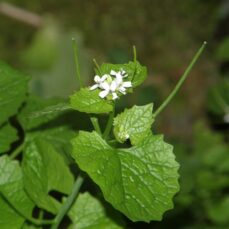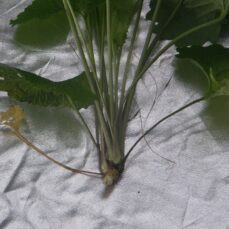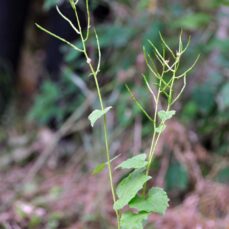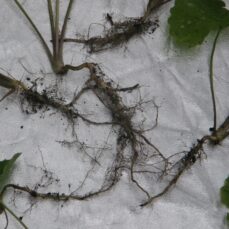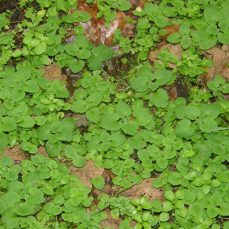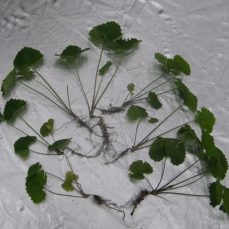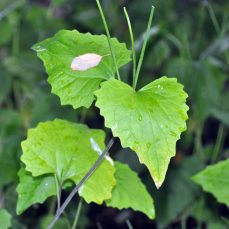Garlic Mustard (Alliaria petiolata)
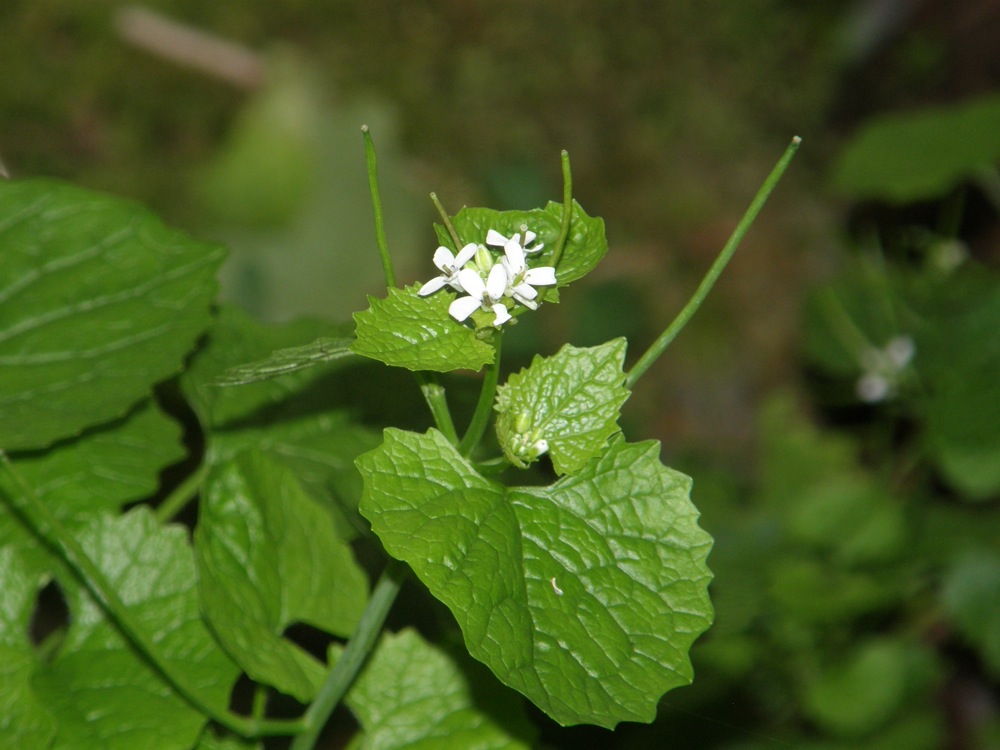
Photo credit: J. Leekie

Management Strategy
Squamish
Whistler
Pemberton
Vectors of Spread
Synonyms
Garlic mustard is also known as hedge garlic.
ID Characteristics
General: Garlic mustard is a biennial plant from the mustard family (Brassicaceae).
Flowers: Small, numerous and white, with four petals.
Leaves: Younger leaves tend to be heart-shaped, while mature leaves are triangular and toothed. Leaves are 5 – 8 cm across, grow in an alternate pattern along the stem, and smell like garlic or onion when crushed.
Stems: In its first year, garlic mustard takes the form of a low-growing carpet which remains green over winter. Second-year flower stalks are 15 – 75 cm tall, with flowers on top. The base of the stems is purple.
Roots: Fibrous white taproot that is typically s-shaped.
Fruits: Several, slender seedpods that are 4 – 6 cm long, and contain black seeds.
Similar Species
The easiest way to distinguish garlic mustard from other plants is to crush the leaves, which emit a strong garlic or onion smell. Please scroll through to find some native species that are often mistaken for garlic mustard:
Wild violet (Viola spp.)

By Arx Fortis at English Wikipedia, CC BY-SA 3.0, https://commons.wikimedia.org/w/index.php?curid=75730337
Nipplewort (Lapsana communis)

By Christian Fischer, CC BY-SA 3.0, https://commons.wikimedia.org/w/index.php?curid=20122238
Sweet cicely (Osmorhiza berteroi)

Sweet Cicely Photo credit: S. Matson
Fringecup (Tellima grandiflora)

By Walter Siegmund – Own work, CC BY 2.5, https://commons.wikimedia.org/w/index.php?curid=2201194
Origin and Habitat
Origin: Garlic mustard is native to Eurasia, and widespread from Sweden all the way to India. It was originally brought to North America by European settlers, and believed to have arrived on Long Island in the 1860’s for culinary use. It was first recorded in British Columbia in 1948.
Habitat: Garlic mustard prefers shaded environments, though it will also survive in full sun. It prefers rich, moist forest floors or wooded stream banks and thrives in medium heat and high moisture. Garlic mustard grows in a wide range of habitats and spreads quickly along roadsides, trails, and fence lines.
How it Spreads
Garlic mustard reproduces by seed and can also re-sprout from its root crown. Each plant can produce upwards of 500 seeds, which remain viable in the soil for 5-10 years. Garlic mustard can also self-pollinate.
Animals, water, and humans commonly disperse garlic mustard seeds, as seeds stick to boots, clothing or fur. The seeds’ ability to survive in the soil for several years also aids in the plant’s dispersal.
Impacts
Ecological:
- Forms dense monocultures that reduce biodiversity.
- Has long-lasting effects on ecosystems; may permanently alter forests, even after removal.
- Releases allelopathic chemicals that change soil chemistry and prevent the growth of other plants.
- Outcompetes and actively displaces native woodland plants.
Economic:
- Carries diseases like mosaic viruses, which may affect other garden plants or crops.
- Reduces the aesthetic value of natural areas (by reducing biodiversity).
- Gives dairy cows’ milk an undesirable garlic flavour if they graze on it.
Stop the Spread
Garlic mustard is not yet found in the Sea to Sky region, but is found in neighbouring areas and may arrive here soon. The goal is to prevent garlic mustard’s introduction by focusing on education and awareness. If prevention fails, the goal will become immediate eradication following the proposed SSISC EDRR protocol.
Learn to identify garlic mustard: use the images on this profile page to learn how to identify garlic mustard.
What to do if you spot it: You can report any garlic mustard sighting by visiting our reporting page.
DO:
- Regularly monitor properties for weed infestations.
- Ensure soil and gravel are uncontaminated before transport.
- Check wildflower mixes to ensure that they do not contain Garlic Mustard.
- Ensure plants are disposed of in a garbage bag if found in floral arrangements to prevent seeds from spreading.
DO NOT:
- Do not unload, park or store equipment or vehicles in infested areas; remove plant material from any equipment, vehicles or clothing used in such areas and wash equipment and vehicles at designated cleaning sites before leaving infested areas.
- Do not plant Garlic Mustard in a garden, no matter how well-contained its enclosure may seem.
- Do not move soil that has been contaminated with Garlic Mustard.
- Do not compost!
Control
Mechanical
- Hand-pull small infestations and bag the plant material immediately for appropriate disposal.
- Make sure you remove at least the upper half of the roots to stop buds at the root crown from sending up new flower stalks.
- Alternatively, garlic mustard can also be mowed to the ground before it flowers, but this method will only suppress the plant in the short term, so remember to revisit the site to control for re-growth. Treatments may need to occur repeatedly until the seed bank is depleted.
Chemical
- Glyphosate, 2,4-D, triclopyr and metsulfuron have proven effective for garlic mustard control, where permitted.
- They work best if applied in early spring or fall.
We recommend that any herbicide application is carried out by a person holding a valid BC Pesticide Applicator Certificate. Before selecting and applying herbicides, you must review and follow herbicide labels and application rates; municipal, regional, provincial and federal laws and regulations; species-specific treatment recommendations, and site-specific goals and objectives.
Biological
There is no biological control available for this plant.
Cultural
- Foraging could also contribute to garlic mustard control, as the leaves are edible and have a mild garlic taste. For more information on edible invasive plants, please check out this page.
- Young leaves can replace basil in pesto recipes and the roots are sometimes used as a substitute for horseradish.
Distribution of Garlic Mustard in B.C.
Garlic Mustard Factsheet
Having trouble viewing the factsheet? Don’t worry, all the information is included on this page. You can also contact us with any questions.
Additional Resources
References
- City of Victoria, Garlic Mustard Invasive Species Alert
- District of Saanich, Garlic Mustard Invasive Species Alert
- Fraser Valley Invasive Species Society, Garlic Mustard
- Government of British Columbia, Garlic Mustard Invasive Species Alert Factsheet
- Invasive Species Centre, Garlic Mustard
- Invasive Species Council of British Columbia, Garlic Mustard
- Michigan State University Extension IPM, About Garlic Mustard
- Nature Conservancy Canada, Garlic Mustard
- Ontario Invasive Plant Council, Best Management Practices in Ontario: Garlic Mustard




